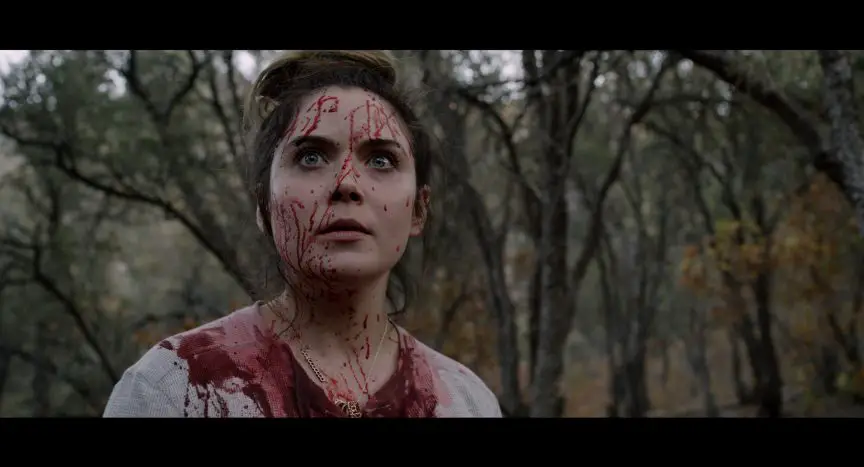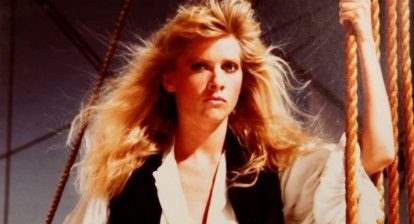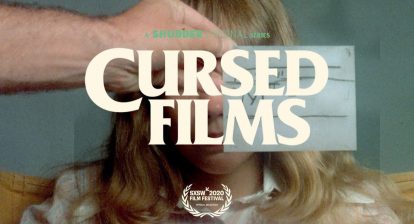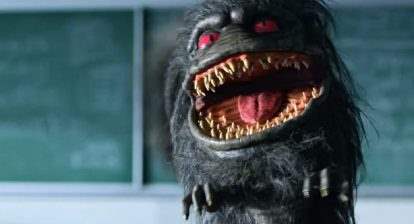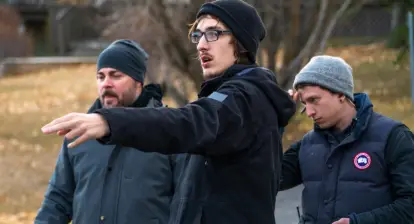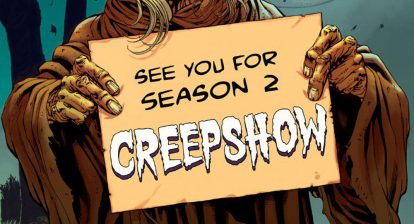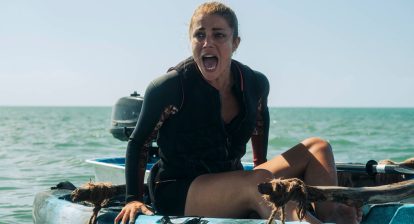Most networks and streaming services celebrate the Halloween season in October, but this year Shudder is kicking things off early with their 61 days to Halloween countdown. One of the first films to commence this special occasion is Brandon Christensen’s Superhost.
In Superhost, travel vloggers Teddy (Osric Chau, Supernatural) and Claire (Sara Canning, Nancy Drew) share their experiences in and around vacation homes with their subscribers while maintaining a moderate level of Internet fame. When their follower count starts to dwindle, they pivot to creating viral content around their most recent host, Rebecca (Gracie Gillam, Z Nation). With all eyes turned towards their “superhost,” Rebecca, they slowly start to realize something isn’t right and as they investigate further, they unlock a horrifying truth. The film stars Chau, Canning, Gillam, and Barbara Crampton (Jakob’s Wife). Clayton Moore was responsible for the film’s cinematography. He previously collaborated with Christensen on Z and It Stains the Sands Red. To learn how Moore achieved the unique look of Superhost we conducted the below Q&A with him.
Wicked Horror: What did pre-production look like on Superhost? Did you story board anything out?
Clayton Moore: Preproduction for Brandon and I is generally easy. We discuss things in broad strokes at first, trying to establish our visual language that sets the tone for the script in the most appropriate way. Then we will get right down to the details and dig in on specific scenes or needs as we encounter them on a read through. I know how Brandon likes to cover scenes and so unless something really stands out to me as being extra challenging there won’t be much of a discussion as I can probably already see the blocking in my head. Some of the bigger sequences we did storyboard ahead of time just to make sure when we got to them, we would have our coverage figured out, but the majority of our storyboarding happens in the morning, when we are planning out our day over coffee and reading our sides, we might sketch up some quick coverage ideas.

Wicked Horror: We heard Superhost director, Brandon Christensen, is a fan of David Fincher. Did any of David’s films specifically influence any of the Superhost shots?
Clayton Moore: You heard right; he is a huge fan of Fincher. I would say in part all of Fincher’s work inspired Superhost in some way or another, we found inspiration in Zodiac and Gone Girl mostly. We were drawn to the tone and look of Gone Girl specifically and found ourselves going back to it again and again in preproduction. Other influences were Creep of course, and Green Room.
Wicked Horror: The two main characters, Claire and Teddy, film a lot of things on their own. What did you do to differentiate these shots?
Clayton Moore: We didn’t want to get too stylized with the character’s footage because it needed to cut in seamlessly with the narrative footage. It’s not “found footage” in the traditional sense because sometimes we cut directly between the narrative camera and the character’s camera. For the character’s footage, we used a different camera than the movie camera, one with a slightly lower quality level. We also didn’t worry too much about lighting for that camera and so we ended up with footage that had a more visceral, raw feeling. That alone gave it a different look, which we then emphasized in post by lowering the contrast and giving it a cooler tone. I think it worked very well; you instantly recognize when the cameras change but it’s not jarring at all.

Wicked Horror: The camera that Claire and Teddy use in the film, like when interviewing Rebecca, is that one of your actual cameras?
Clayton Moore: Yep, it is an older camera, but it still looks the part of being a nice, big, expensive, professional camera that they might use for their vlog channel and it makes a great prop for the film that could actually function when we needed it to!
Wicked Horror: The use of shadows play a big part in horror films. I noticed that in many of the close-up shots of the characters’ faces, one half of their face is normally in the shadows. What was your reasoning behind this?
Clayton Moore: The majority of this film takes place in daylight, and there are a lot of lighter, humorous moments in the film. However, it is a horror film, and I still wanted to maintain that sense of mystery and uncertainty about these characters. You could say it’s a metaphor for their two-faced nature between their on-line personas and their real-life personas. Everyone is hiding something in this film, so I wanted to use light and shadow to convey that albeit subtly. 
Wicked Horror: What was the most difficult scene for you to film? Why?
Clayton Moore: There is a long, slow dolly move of Claire working at her computer late at night. The camera starts behind her, and dollies in over her shoulder and pans to see her face. It doesn’t seem like an overly complicated shot, but we didn’t really have the right equipment to make it work easily. It was a classic case of having to use what we had available to us. A big camera dolly with an offset arm would have been preferred, but due to the location and our small crew it just wouldn’t have been feasible to have a dolly of that size. I had to make the shot using a long doorway dolly track on the floor, with a lightweight dolly sled designed for shorter moves. I had to operate the camera from a high hat which was set to the correct height with apple boxes and ratchet strapped to the tiny dolly on the floor. We piled a bunch of sandbags on it to try and even the weight distribution and that helped a little bit, but it was still pretty wobbly. To make it even more difficult, I was shooting wide open so my first AC had to really be on his toes with the focus pull and I had to make sure to be smooth as butter as any movement I made would translate into the dolly. It took a few takes, and it was far from ideal, but it did give us the shot we needed and in the end that’s all that matters.
Wicked Horror: During a scene that is supposed to be in pitch black darkness, such as the one where Claire and Teddy wake up in the middle of the night, what is the key to making the light look as natural as possible?
Clayton Moore: Our brains are well trained to recognize nighttime on film. It is usually dark and blue. Hardly ever does it look completely realistic because you still must expose an image; there needs to be light to see dark, so it comes down to how much contrast you decide to use in your lighting, and thus how much control you can have over your lighting. For night scenes I like to use soft sources from overhead to give the room a base level of ambient light and then supplement with harder sources from behind to throw shadows across the ground or across walls. These would replicate reflected light, from the moon, or even artificial lighting like a porch light or streetlamp.
If I backlight the characters I can see their silhouette against a dark background, and then from there I can control how much of that light I want to bounce back into seeing their faces, and how much more light I want to have in the background. When you get to that point there is a fine line between looking natural and looking fake. It can get tricky sometimes and honestly less is usually more. It all depends on the story you’re trying to tell.
Wicked Horror: Are you personally a fan of the horror genre? If so, what are some of your favorite films?
Clayton Moore: I do enjoy the horror genre. Some of my favorites are the classics I grew up with. Friday the 13th, Nightmare on Elm Street, The Shining, The Thing, Alien… as far as more recent stuff I absolutely love Stranger Things, The Haunting of Hill House, The Wailing, It Follows, The Conjuring, Annihilation, and Ex Machina. I could go on, there is a ton of really good stuff out there!
Wicked Horror: Do you have a favorite memory from filming with Barbara Crampton. She has become somewhat of a horror legend with all her work in the genre.
Clayton Moore: My favorite memory of working with Barbara was really the entire experience. We only had her for 2 days, and on her second day we shot her biggest scene. We had something like 40 setups on that scene, so there was a lot to cover, and we knew it was our last day with her. There was no room for error! She spent a lot of time that day, in the dirt, with a bag over her head. And it was cold, we shot in October, and we were up around 8500 feet elevation. We shot her big blood scene last and once again she was laying in the dirt, but this time covered in blood. Not once did she complain, she was a true professional and a pleasure to work with. I have nothing but good things to say about her, she is a beautiful, wonderful human being and we were so lucky to be able to have her in our film!
